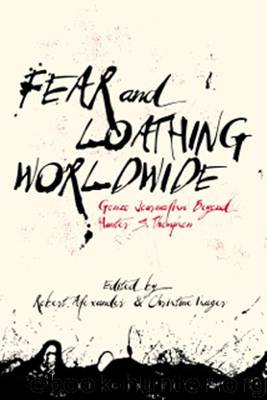Fear and Loathing Worldwide by Robert Alexander Christine Isager

Author:Robert Alexander,Christine Isager
Language: eng
Format: epub
Publisher: Bloomsbury USA
10
SoHo, la revista prohibida para las mujeres: Gonzo by women in a Colombian men’s magazine
Carlos A. Cortés-Martínez, Joy Jenkins and Berkley Hudson
Scholarship on Gonzo journalism usually emphasizes Western examples relying on male perspectives. This study uses textual analysis to examine Latin American women writers’ contributions to Gonzo journalism from rhetorical and feminist perspectives. The authors analyzed female-authored narrative journalism in SoHo, a Colombian men’s magazine. The study identified how these women journalists used Gonzo techniques such as dialogue, character development, field sketches, humor, and irreverence. The study also considered how these narratives addressed gender. Although the feature stories tended to reinforce heteronormative roles, privileging male interests and reinforcing gender stereotypes, the findings also show evidence of responsible representation.
Journalist Hunter S. Thompson rose to fame with his intimate look at the Hell’s Angels motorcycle gang in a 1965 Nation article and subsequent book. But he grew to notoriety through his “Gonzo” reporting, featured prominently in his 1970 Scanlan’s Monthly article “The Kentucky Derby Is Decadent and Depraved” and his 1971 Rolling Stone articles “Fear and Loathing in Las Vegas: A Savage Journey to the Heart of the American Dream.” The “drug-addled, subversive, subjective method” of literary journalism (Winston 2014: 1) emphasizes Thompson’s inner monologue (Coward 2013) and “draws upon fictional techniques to describe non-fictional situations” (Zelizer and Allan 2010: 51). A “celebrity outlaw journalist,” Thompson was known for his passion for guns, activist politics, and alcohol and drug use (Winston 2014: 2). Thompson and other “New Journalists” of the 1960s, such as Norman Mailer, Tom Wolfe, and Gay Talese, wrote for magazines including True, New York, and Esquire, and aimed to redefine the conventions of news reporting and feature writing (Coward 2013).
The emergence of Gonzo in the 1960s and 1970s in the United States dovetailed with the rise of the Second Wave feminist movement. Scholars have examined the role of media in perpetuating discrimination against women, including stereotypical female media images and the obstacles female journalists face (Gallagher 2003). The lack of women’s topics and voices has also raised concerns (Van Zoonen 1994, 2002). Although the number of women securing journalism jobs globally has increased over the last few decades, men continue to hold powerful positions in newsrooms and define newsroom culture (Carter, Branson, and Allan 2002), which could result in a male-dominated view in media content (Gill 2007). Female journalists who take a more human, involved approach to news, however, may find enhanced opportunities in news organizations (Van Zoonen 2002). Some female journalists have also adopted the tenets of Gonzo.
This study considers how Hunter S. Thompson’s legacy has extended to Latin America. We compared the principles of Gonzo as enacted by Thompson with stories by female journalists in the Colombian men’s monthly magazine SoHo. Since 1999, SoHo has become one of the most prominent publications in Latin America and compares to a combination of Playboy, Esquire, and GQ—all venues for Thompson. In the study that we report here, we have critically assessed how these journalists applied Gonzo techniques to topics
Download
This site does not store any files on its server. We only index and link to content provided by other sites. Please contact the content providers to delete copyright contents if any and email us, we'll remove relevant links or contents immediately.
4 3 2 1: A Novel by Paul Auster(12328)
The handmaid's tale by Margaret Atwood(7705)
Giovanni's Room by James Baldwin(7246)
Asking the Right Questions: A Guide to Critical Thinking by M. Neil Browne & Stuart M. Keeley(5705)
Big Magic: Creative Living Beyond Fear by Elizabeth Gilbert(5674)
Ego Is the Enemy by Ryan Holiday(5344)
The Body: A Guide for Occupants by Bill Bryson(5026)
On Writing A Memoir of the Craft by Stephen King(4891)
Ken Follett - World without end by Ken Follett(4681)
Adulting by Kelly Williams Brown(4529)
Bluets by Maggie Nelson(4510)
Eat That Frog! by Brian Tracy(4479)
Guilty Pleasures by Laurell K Hamilton(4391)
The Poetry of Pablo Neruda by Pablo Neruda(4063)
Alive: The Story of the Andes Survivors by Piers Paul Read(3994)
White Noise - A Novel by Don DeLillo(3979)
Fingerprints of the Gods by Graham Hancock(3963)
The Book of Joy by Dalai Lama(3940)
The Bookshop by Penelope Fitzgerald(3810)
